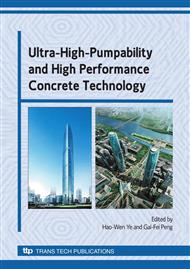p.186
p.191
p.197
p.204
p.212
p.219
p.226
p.234
p.242
Internal Curing of Saturated Lightweight Aggregate in High Performance Combined Concrete
Abstract:
This paper investigated the mechanical properties, workability, autogenous shrinkage, drying shrinkage and durability of the high performance combined aggregate concrete with the coarse aggregate replaced by the lightweight aggregate in the volume fraction from 0% to 50%. The results demonstrated that the fresh concrete with the lightweight aggregate volume fraction of 10% and 30% had good workability, but degrade with a high volume fraction of 50 %. The hardened concrete with 10% and 30% lightweight aggregate replacement had similar compressive strength and splitting tensile strength comparing to the reference concrete without adding lightweight aggregate. The concrete with 50% lightweight aggregate replacement showed decreased compressive strength and splitting tensile strength. The concrete adding lightweight aggregate exhibited less autogenous shrinkage and drying shrinkage than the reference concrete without adding lightweight aggregate. The autogenous shrinkage and drying shrinkage increased with the increasing lightweight aggregate volume fraction. The concrete containing lightweight aggregate showed good durability after 200 freezing and thawing cycles, but the chloride permeability efficiency of concrete decreased.
Info:
Periodical:
Pages:
212-218
Citation:
Online since:
January 2009
Authors:
Price:
Сopyright:
© 2009 Trans Tech Publications Ltd. All Rights Reserved
Share:
Citation:


